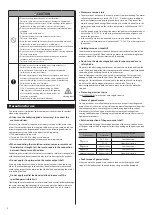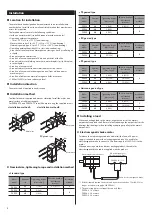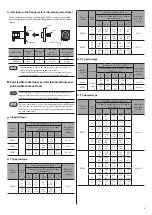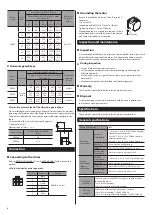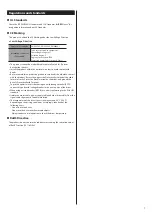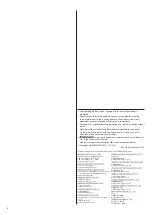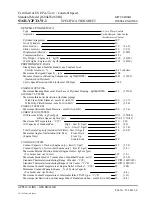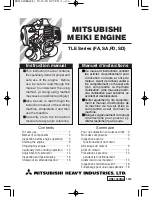
2
y
Do not use the product beyond its specifications.
This may cause electric shock, injury or damage to equipment.
y
Keep your fingers and objects out of the openings in the product.
Failure to do so may result in fire, electric shock or injury.
y
Do not touch the product during operation or immediately after
stopping.
This may cause a skin burn(s).
y
Do not hold the motor output shaft or motor cable.
This may cause injury.
y
Keep the area around the product free of combustible materials.
Failure to do so may result in fire or a skin burn(s).
y
Leave nothing around the product that would obstruct ventilation.
Failure to do so may result in damage to equipment.
y
Do not touch the rotating parts (output shaft etc.) during operation.
This may cause injury.
y
Do not touch the terminals while performing the insulation
resistance test or dielectric strength test.
This may cause electric shock.
y
Provide a cover over the rotating parts (output shaft etc.).
Failure to do so may result in injury.
y
Use a motor and driver only in the specified combination.
Failure to do so may result in fire.
y
Provide an emergency stop device or emergency stop circuit
external to the equipment so that the entire equipment will
operate safely in the event of a system failure or malfunction.
Failure to do so may result in injury.
y
The motor surface temperature may exceed 70 °C
(158 °F) even under normal operating conditions.
If the operator is allowed to approach the running
motor, attach a warning label as shown below in a
conspicuous position.
Failure to do so may result in skin burn(s).
Warning label
Precautions for use
This section covers limitations and requirements the user should consider
when using the product.
•
Always use the cable (supplied or accessory) to connect the
motor and driver.
Be sure to use the cable (supplied or accessory) to connect the motor and
driver. If a cable other than the supplied cable or accessory cable is used, the
driver may generate a large amount of heat. In the following condition, an
appropriate accessory cable must be purchased separately.
y
If a flexible cable is to be used.
y
If a cable of 3 m (9.8 ft.) or longer is to be used.
y
If a motor and driver package without a cable was purchased.
•
When conducting the insulation resistance measurement and
the dielectric strength test, be sure to separate the connection
between the motor and the driver.
Conducting the insulation resistance measurement or dielectric strength test
with the motor and driver connected may result in damage to the product.
•
Do not apply strong impact on the motor output shaft.
If you are using a motor with encoder, an optical encoder is housed in the
motor. To prevent damage to the encoder, handle the motor with care and
avoid strong impact to the motor output shaft when transporting the motor
or installing the load.
•
Do not apply a radial load and axial load in excess of the
specified permissible limit.
Operating the motor under an excessive radial load or axial load may damage
the motor bearings (ball bearings). Be sure to operate the motor within the
specified permissible limit of radial load and axial load. See p.5 for details.
•
Motor case temperature
y
The motor does not have a function to protect from overheating. The motor
surface temperature may exceed 100 °C (212 °F) under certain conditions
(ambient temperature, operating speed, duty cycle, etc.). To prevent the
motor bearings (ball bearings) from reaching its usable life quickly, use the
motor in conditions where the surface temperature will not exceed 100 °C
(212 °F).
y
Use the geared motor in a condition where the gear case temperature does
not exceed 70 °C (158 °F), in order to prevent deterioration of grease and
parts in the gear case.
y
In the case of a motor with an encoder, use it in a condition where the
motor surface temperature will not exceed 85 °C (185 °F) in order to protect
the encoder.
•
Holding torque at standstill
The motor holding torque is reduced by the current cutback function of the
driver at motor standstill. When selecting a motor, check the holding torque
at motor standstill in the specifications on the catalog.
•
Do not use the electromagnetic brake to reduce speed or as a
safety brake.
Do not use the electromagnetic brake as a means to decelerate and stop the
motor. The brake hub of the electromagnetic brake will wear significantly and
the braking force will drop if used to stop the motor.
The electromagnetic brake is a power-off activated type. This means that
although it helps maintain the position of the load in the event of power
outage, etc., this brake cannot securely hold the load in place. Accordingly,
do not use the electromagnetic brake as a safety brake. To use the
electromagnetic brake to hold the load in place, do so after the motor has
stopped.
•
Preventing electrical noise
See USER MANUAL for measures with regard to noise.
•
Grease of geared motor
On rare occasions, a small amount of grease may ooze out from the geared
motor. If there is concern over possible environmental damage resulting from
the leakage of grease, check for grease stains during regular inspections.
Alternatively, install an oil pan or other device to prevent leakage from
causing further damage. Oil leakage may lead to problems in the customer’s
equipment or products.
•
Rotation direction of the gear output shaft
The relationship between the rotation direction of the motor shaft and that
of the gear output shaft changes as follows, depending on the gear type and
gear ratio.
Type of gear
Gear ratio
Rotation direction
(relative to the motor rotation direction)
TS
geared
3.6, 7.2, 10
Same direction
20, 30
Opposite direction
FC
geared
All gear ratios
Same direction
PS
geared
All gear ratios
Same direction
Harmonic geared
All gear ratios
Opposite direction
•
Peak torque of geared motor
Always operate the geared motor under a load not exceeding the peak
torque. If the load exceeds the peak torque, the gear will be damaged.


